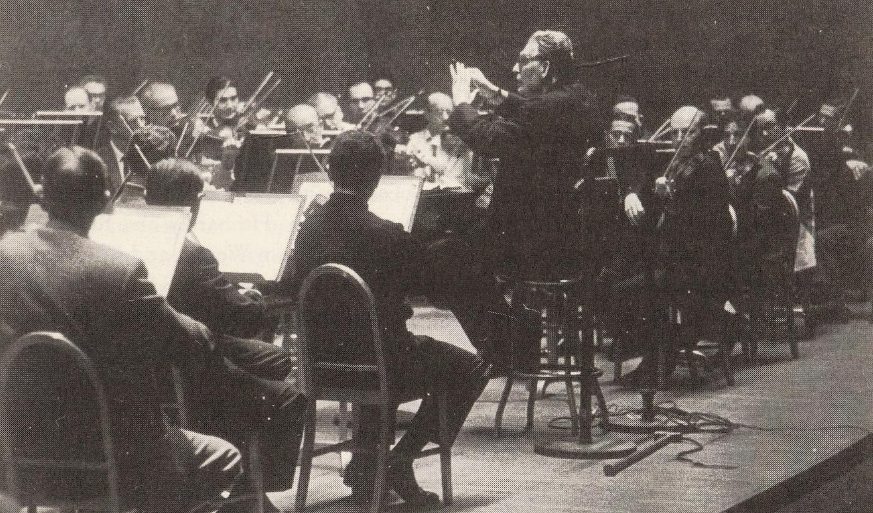In those years when Central Europe began to rebuild itself upon the rubble of World War II, a number of German conductors—emigrés and wartime remainers alike—had already fled to their homeland’s alpine neighbor to the south. Switzerland, memorably gibed by another postwar cultural figure as a five-hundred year peaceful democracy whose greatest contribution to world culture was the cuckoo clock, would be the setting where Otto Klemperer, Carl Schuricht, and Hans Rosbaud all breathed their last.
Although his dying weeks were spent in Wiesbaden, Germany (and was ultimately laid to rest about an hour’s drive south in Heidelberg), it was in Clarens—today a suburban municipality of Montreux, the second largest city in the majority Francophone canton of Vaud—where Wilhelm Furtwängler made his final home. He had known the country well since his journeyman days as third conductor at the Opernhaus Zürich, a brief and rocky engagement which drew to an abrupt close after a disastrous performance of The Merry Widow. As a lifelong mountaineer and skier, the Swiss Alps were naturally his frequent vacation destinations. But the chain of events which made Switzerland his adopted homeland was borne out of more worrisome considerations.
On January 23, 1945, Furtwängler led his last concert in Nazi Berlin. Allied bombing had pulverized the old Philharmonie and Staatsoper, forcing the Berlin Philharmonic to decamp for the Blüthner-Saal. At the concert’s intermission none other than Albert Speer, Reich Minister of Armaments and War Production, came to pay the conductor a visit in the green room. He pointedly asked Furtwängler what his plans in the near future would be. Only days before, Speer had learned of the Soviet capture of the strategic industrial region of Silesia, an outcome which terminated any wild hopes the Nazi leadership may have entertained for a conclusion to the war that resulted in anything other than Germany’s unconditional surrender. When Furtwängler replied that he was engaged to conduct in Switzerland in a matter of weeks, Speer subtly suggested that he extend his stay there. “After all,” he coolly remarked to the conductor, “you look so very tired.” The hint was taken.
Five days later in Vienna, Furtwängler conducted his final concert in the crumbling German Reich: A program of Franck, Brahms, and Beethoven with the Vienna Philharmonic (an event gratefully preserved for posterity). Earlier that day, he had slipped on ice and suffered a concussion. Not only did this threaten to derail the concert, but it also jeopardized his ulterior motive for which the performance had served as pretext. Recuperating at the city’s Hotel Imperial, which only a few weeks later would be among the many structures damaged and destroyed in the Allied bombing of Vienna, he received an urgent call from a mysterious bureaucrat at the Foreign Office in Berlin demanding to know who signed off on Furtwängler’s exit visa. In the early hours of the next morning, the conductor was surreptitiously led out of the hotel, placed on a milk train, and (after a number of stops and changes) eventually arrived at the town of Dornbirn along the Austro-Swiss border. Days later, after a last burst of cloak-and-dagger intrigue, Furtwängler crossed over into Switzerland.
While he and his family were grateful for the safe passage provided to them by the Swiss authorities, the country’s press and many of its citizens were less than thrilled about receiving a man they considered a Nazi cultural grandee. Leftist publications and political groups called for a ban on his performances, claiming that the purity of Swiss neutrality was at stake. In late February, a Furtwängler concert in Winterthur was disrupted by protesters with stink bombs, dispersing only when local police turned water hoses on them. Heeding the advice of friends who suggested that he step away from public life at least for a time, the conductor checked himself into a sanatorium in Clarens where he waited out the inevitable end to the war.
By the time of this Lugano concert on May 15, 1954, that animosity had long dissipated. Thanks to friends and colleagues such as Ernest Ansermet and Edwin Fischer, Furtwängler firmly established himself in Swiss musical life, becoming especially associated with the Lucerne Festival. Few in the audience at the Teatro Apollo that day would have guessed that this would be among the conductor’s very last public performances, although his intimates were well aware of the hearing loss which was making him increasingly despondent. Whether his sorrow over that played a part in the valedictory tone of these performances (or in his death six months later) is impossible to ascertain. But there is a sense, such as one hears in this performance of the Beethoven Pastoral, of its “cheerful and thankful feelings” for life made bittersweet by one’s awareness of its transience. It would be a mistake to believe, however, that these performances are exhausted, weak. While his earlier studio recordings of Strauss’ Till Eulenspiegel are more polished, neither matches this performance’s fusion of tragic power and grim irony. Equally rewarding and revealing is his accompaniment to Yvonne Lefébure’s magisterial interpretation of the Mozart Piano Concerto No. 20, the best known part of this concert, as well as the only recorded collaboration between these two extraordinary artists.
One wonders whether Furtwängler was familiar with Miguel de Unamuno’s Of the Tragic Feeling of Life: “Only the weak resign themselves to final death and substitute some other desire for the longing for personal immortality. In the strong the zeal for perpetuity overrides the doubt of realizing it, and their superabundance of life overflows upon the other side of death.” Regardless, something of that permeates this concert; a testament to the inextinguishable lifeforce of music, of the artists documented here, long since vanished into the eternity of history.
This essay will be included in the liner notes of a forthcoming reissue of Furtwängler’s May 1954 Lugano concert on the Japanese ATS label.
Furtwängler (left) with Ernest Ansermet shortly after fleeing to Switzerland, February 1945.


